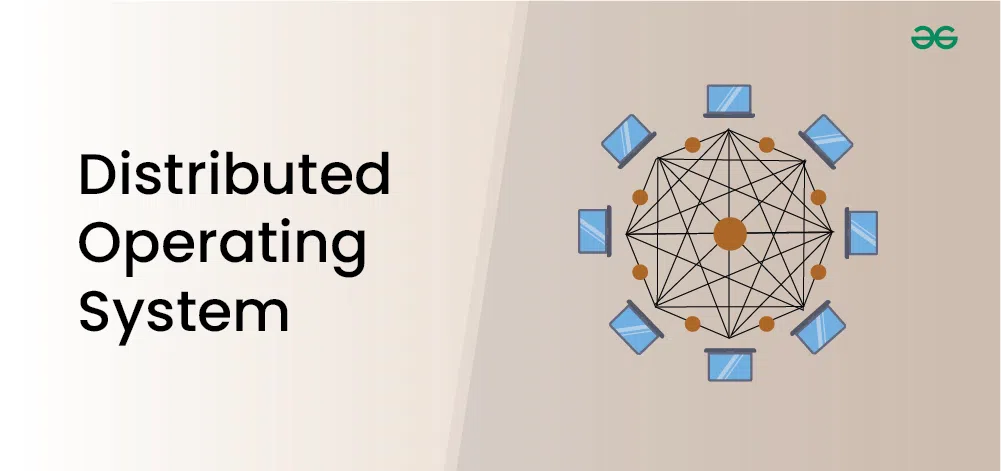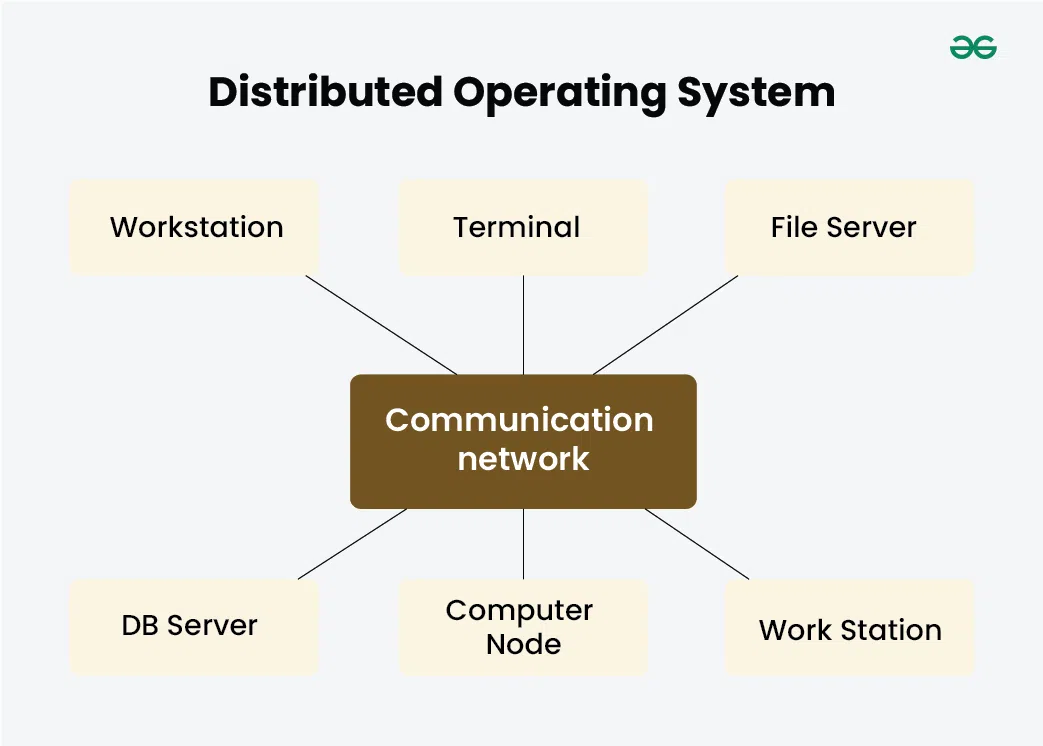What is a Distributed Operating System?
Last Updated :
29 Apr, 2024
A Distributed Operating System refers to a model in which applications run on multiple interconnected computers, offering enhanced communication and integration capabilities compared to a network operating system.

Important Topics for a Distributed Operating System
What is a Distributed Operating System?
In a Distributed Operating System, multiple CPUs are utilized, but for end-users, it appears as a typical centralized operating system. It enables the sharing of various resources such as CPUs, disks, network interfaces, nodes, and computers across different sites, thereby expanding the available data within the entire system.
Effective communication channels like high-speed buses and telephone lines connect all processors, each equipped with its own local memory and other neighboring processors.
Due to its characteristics, a distributed operating system is classified as a loosely coupled system. It encompasses multiple computers, nodes, and sites, all interconnected through LAN/WAN lines. The ability of a Distributed OS to share processing resources and I/O files while providing users with a virtual machine abstraction is an important feature.
The diagram below illustrates the structure of a distributed operating system:

Types of Distributed Operating System
There are many types of Distributed Operating System, some of them are as follows:
1. Client-Server Systems
In a client-server system within a distributed operating system, clients request services or resources from servers over a network. Clients initiate communication, send requests, and handle user interfaces, while servers listen for requests, perform tasks, and manage resources.
- This model allows for scalable resource utilization, efficient sharing, modular development, centralized control, and fault tolerance.
- It facilitates collaboration between distributed entities, promoting the development of reliable, scalable, and interoperable distributed systems.
2. Peer-to-Peer(P2P) Systems
In peer-to-peer (P2P) systems, interconnected nodes directly communicate and collaborate without centralized control. Each node can act as both a client and a server, sharing resources and services with other nodes. P2P systems enable decentralized resource sharing, self-organization, and fault tolerance.
- They support efficient collaboration, scalability, and resilience to failures without relying on central servers.
- This model facilitates distributed data sharing, content distribution, and computing tasks, making it suitable for applications like file sharing, content delivery, and blockchain networks.
3. Middleware
Middleware acts as a bridge between different software applications or components, enabling communication and interaction across distributed systems. It abstracts complexities of network communication, providing services like message passing, remote procedure calls (RPC), and object management.
- Middleware facilitates interoperability, scalability, and fault tolerance by decoupling application logic from underlying infrastructure.
- It supports diverse communication protocols and data formats, enabling seamless integration between heterogeneous systems.
- Middleware simplifies distributed system development, promotes modularity, and enhances system flexibility, enabling efficient resource utilization and improved system reliability.
4. Three-Tier
In a distributed operating system, the three-tier architecture divides tasks into presentation, logic, and data layers. The presentation tier, comprising client machines or devices, handles user interaction. The logic tier, distributed across multiple nodes or servers, executes processing logic and coordinates system functions.
- The data tier manages storage and retrieval operations, often employing distributed databases or file systems across multiple nodes.
- This modular approach enables scalability, fault tolerance, and efficient resource utilization, making it ideal for distributed computing environments.
5. N-Tier
In an N-tier architecture, applications are structured into multiple tiers or layers beyond the traditional three-tier model. Each tier performs specific functions, such as presentation, logic, data processing, and storage, with the flexibility to add more tiers as needed. In a distributed operating system, this architecture enables complex applications to be divided into modular components distributed across multiple nodes or servers.
- Each tier can scale independently, promoting efficient resource utilization, fault tolerance, and maintainability.
- N-tier architectures facilitate distributed computing by allowing components to run on separate nodes or servers, improving performance and scalability.
- This approach is commonly used in large-scale enterprise systems, web applications, and distributed systems requiring high availability and scalability.
Applications of Distributed Operating System
Distributed operating systems find applications across various domains where distributed computing is essential. Here are some notable applications:
- Cloud Computing Platforms:
- Distributed operating systems form the backbone of cloud computing platforms like Amazon Web Services (AWS), Microsoft Azure, and Google Cloud Platform (GCP).
- These platforms provide scalable, on-demand computing resources distributed across multiple data centers, enabling organizations to deploy and manage applications, storage, and services in a distributed manner.
- Internet of Things (IoT):
- Distributed operating systems play a crucial role in IoT networks, where numerous interconnected devices collect and exchange data.
- These operating systems manage communication, coordination, and data processing tasks across distributed IoT devices, enabling applications such as smart home automation, industrial monitoring, and environmental sensing.
- Distributed Databases:
- Distributed operating systems are used in distributed database management systems (DDBMS) to manage and coordinate data storage and processing across multiple nodes or servers.
- These systems ensure data consistency, availability, and fault tolerance in distributed environments, supporting applications such as online transaction processing (OLTP), data warehousing, and real-time analytics.
- Content Delivery Networks (CDNs):
- CDNs rely on distributed operating systems to deliver web content, media, and applications to users worldwide.
- These operating systems manage distributed caching, content replication, and request routing across a network of edge servers, reducing latency and improving performance for users accessing web content from diverse geographic locations.
- Peer-to-Peer (P2P) Networks:
- Distributed operating systems are used in peer-to-peer networks to enable decentralized communication, resource sharing, and collaboration among distributed nodes.
- These systems facilitate file sharing, content distribution, and decentralized applications (DApps) by coordinating interactions between peers without relying on centralized servers.
- High-Performance Computing (HPC):
- Distributed operating systems are employed in HPC clusters and supercomputers to coordinate parallel processing tasks across multiple nodes or compute units.
- These systems support scientific simulations, computational modeling, and data-intensive computations by distributing workloads and managing communication between nodes efficiently.
- Distributed File Systems:
- Distributed operating systems power distributed file systems like Hadoop Distributed File System (HDFS), Google File System (GFS), and CephFS.
- These file systems enable distributed storage and retrieval of large-scale data sets across clusters of machines, supporting applications such as big data analytics, data processing, and content storage.
Examples of Distributed Operating System
Below are some Examples of Distributed Operating System.
- Solaris: The SUN multiprocessor workstations are the intended use for it.
- OSF/1: The Open Foundation Software Company designed it, and it works with Unix.
- Micros: All nodes in the system are assigned work by the MICROS operating system, which also guarantees a balanced data load.
- DYNIX: It is created for computers with many processors, known as Symmetry.
- Locus: It can be viewed simultaneously from both local and distant files without any location restrictions.
- Mach: It permits the features of multitasking and multithreading.
Security in Distributed Operating system
Protection and security are crucial aspects of a Distributed Operating System, especially in organizational settings. Measures are employed to safeguard the system from potential damage or loss caused by external sources. Various security measures can be implemented, including authentication methods such as username/password and user key. One Time Password (OTP) is also commonly utilized in distributed OS security applications.
Advantages of Distributed Operating System
Below are some Advantages of Distributed Operating System.
- It can increase data availability throughout the system by sharing all resources (CPU, disk, network interface, nodes, computers, and so on) between sites.
- Because all data is replicated across all sites, it reduces the probability of data corruption because users can access data from another operating site in the event that one site fails.
- Data transfer from one site to another is accelerated by it.
- Since it may be accessible from both local and remote sites, it is an open system.
- It facilitates a reduction in the time needed to process data.
- The majority of distributed systems are composed of multiple nodes that work together to provide fault tolerance. Even if one machine malfunctions, the system still functions.
Disadvantages of Distributed Operating System
Below are some Disadvantages of Distributed Operating System.
- Which tasks need to be completed, when they need to be completed, and where they need to be completed must be determined by the system. The restrictions of a scheduler might result in unpredictable runtimes and unused hardware.
- Since the nodes and connections in DOS need to be secured, it is challenging to establish sufficient security.
- Comparing a DOS-connected database to a single-user system, the latter is easier to maintain and less complex.
- Compared to other systems, the underlying software is incredibly sophisticated and poorly understood.
- Compiling, analyzing, displaying, and keeping track of hardware utilization metrics for large clusters may be quite challenging.
FAQs on Distributed Operating System
Q.1: What is Distributed processing?
Answer:
In order to increase a computer’s or other device’s functionality, distributed processing involves setting up numerous separate central processing units (CPU) to work on the same programs, functions, or systems.
Q.2: Where is distributed processing used?
Answer:
Peer-to-peer applications, SOA-based systems, and massively multiplayer online games are a few examples of distributed systems.
Q.3: Is internet a distributed system?
Answer:
Yes, The most well-known example of distributed system is the Internet.
Share your thoughts in the comments
Please Login to comment...